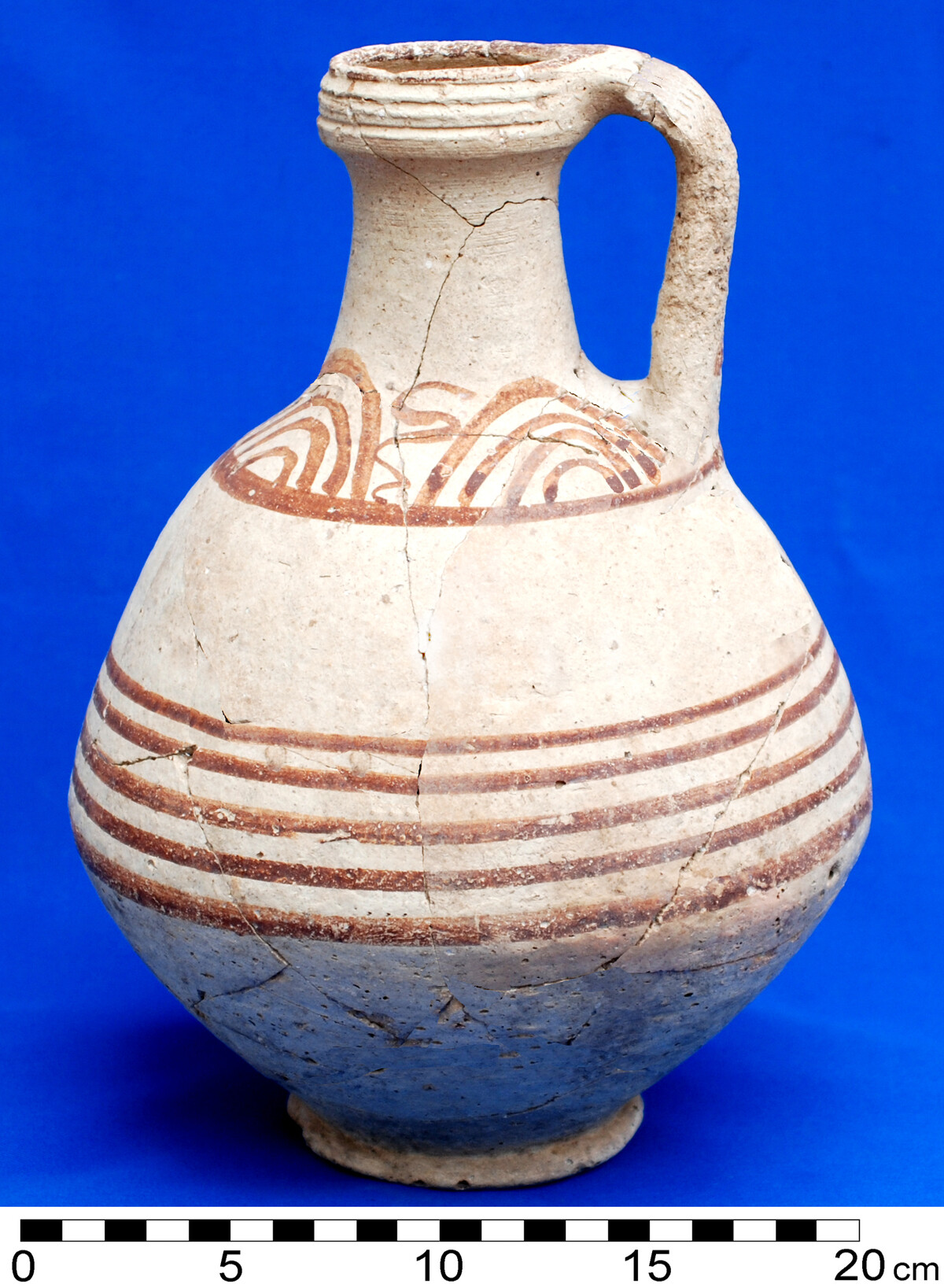An Early Iron Age Compound at Tell Abu al-Kharaz, Jordan Valley: Intercultural Relations in the Eastern Mediterranean around 1100 BCE
In the framework of this PhD project the material culture of the early Iron Age (ca. 11th century BCE) at Tell Abu al-Kharaz in the Jordan Valley was investigated. A specific focus laid on aspects of continuity vs. transformation, tradition vs. innovation and transcultural contacts after the period of upheaval at the Late Bronze to Early Iron Age transition.
The project, conducted in the framework of a Doctoral Fellowship of the Austrian Academy of Sciences and supported by a Marietta Blau fellowship of the Austrian Federal Minister of Science, Research and Economy, deals with the material culture and intercultural connections of the Early Iron Age society of the city of Tell Abu al-Kharaz in the northern part of the Jordan Valley. The basis for this study is an extremely well preserved two-storey-compound excavated by the Swedish Jordan Expedition under the direction of Prof. Peter M. Fischer between 2009 and 2012. Twenty-one rooms of the building revealed more than 200 intact or complete ceramic vessels, including bowls, chalices, goblets, kraters, juglets, pyxides, pilgrim flasks, jugs, jars/storage jars, cooking pots, lamps and a probable incense stand. Some of the vessels contained organic remains, for instance wheat, barley, millet, chickpeas and olives. Other finds are alabaster-calcite vessels, stone bowls, spindle whorls and loom weights, beads and scarabs, various metal objects, stone tools and complete transportable ovens. Fifteen radiocarbon dates support the dating of the destruction of the building in the first half of the 11th century BCE, i.e. Iron Age I.
The early Iron Age pottery and other finds at Tell Abu al-Kharaz indicate a high degree of continuity from the Late Bronze Age. On the other hand, there are a number of innovations, which reflect an amalgamation of new, foreign, and traditional, local traits. This combination of continuity and innovation is consistent with finds from other sites in the Jordan and the Jezreel Valleys. Foreign traits, which are visible in the material culture of early Iron Age Tell Abu al-Kharaz, are mainly from the Eastern Mediterranean, Cypriot and Aegean spheres of culture. There are a number of Phoenician imports, whereas the Egyptian influence is negligible. Western traits are reflected in fine ceramic wares and small portable objects, which were most likely traded, together with objects which were locally produced. These include new types of cooking pots and loom weights, which indicate changes in cooking and dietary habits, and in domestic textile production. This evidence demonstrates a wealthy Early Iron Age society at Tell Abu al-Kharaz with far-reaching intercultural connections.
The PhD thesis with the title »An Early Iron Age Compound at Tell Abu al-Kharaz, Jordan Valley: Tradition, Innovation, and Intercultural Relations in the Eastern Mediterranean around 1100 BCE« was submitted at the University of Vienna in November 2015 and defended in January 2016.
Publications
Publications
- T. Bürge, Between Tradition and Innovation in the Late Bronze to Early Iron Age Transition in Transjordan: Evidence of Migration at Tell Abu al-Kharaz, Jordan Valley?, in: Fischer, P.M. und Bürge, T. (Hrsg.), “Sea Peoples” Up-to-Date. New Research on Transformations in the Eastern Mediterranean in the 13th–11th Centuries BCE (Contributions to the Chronology of the Eastern Mediterranean 35) Vienna 2017, 299–327.
- T. Bürge und P.M. Fischer, Sea Peoples at Tall Abu al-Kharaz, Jordan Valley: New Evidence from the Early Iron Age. Studies in the History and Archaeology of Jordan XII, Amman 2016, 597–615.
- T. Bürge, Tell Abu al-Kharaz: Eine blühende Siedlung am Jordan in der frühen Eisenzeit (ca. 1100 v. Chr.). Antike Welt. Zeitschrift für Archäologie und Kulturgeschichte 6/2015, 76–83.
- P.M. Fischer und T. Bürge, Influences of the Sea Peoples in Transjordan: The Early Iron Age at Tell Abu al-Kharaz. Zeitschrift des Deutschen Palästina Vereins 129/2, 2013, 132–170.
Presented Papers
Presented Papers
- T. Bürge, The Late Bronze to Early Iron Age Transition in Transjordan: Eastern Mediterranean Material Influences. ASOR 2017, Boston (16.11.2017)
- T. Bürge, Der Übergang von der Spätbronzezeit zur frühen Eisenzeit in Transjordanien: Kontinuität und Wandel, Handel und Migration. OREA, ÖAW, Wien (19.10.2016)
- T. Bürge und P. M. Fischer, Iron Age I at Tell Abu al-Kharaz, Jordan Valley: Philistine and Other Influences. The Aegean and the Levant at the Turn of the Bronze and Iron Ages, University of Warsaw (12.06.2015)
- T. Bürge, Tell Abū el-Ḫaraz im Jordantal: Interkulturelle Kontakte während der frühen Eisenzeit (ca. 1100 v. Chr.). Wissenschaftliches Kolloquium des Deutschen Vereins zur Erforschung Palästinas, Mainz (15.11.2014)
- T. Bürge, “Sea Peoples Phenomena” in Early Iron Age Tell Abu al-Kharaz, Jordan Valley? ESF Exploratory Workshop: The Sea Peoples Up-To-Date. New Research on the Migration of Peoples in the 12th Century BCE, Wien (03.11.2014)
- T. Bürge, Sea Peoples at Tall Abu al-Kharaz, Jordan Valley: New Evidence from the Early Iron Age. 12th International Conference on the History and Archaeology of Jordan, Berlin (10.05.2013)

